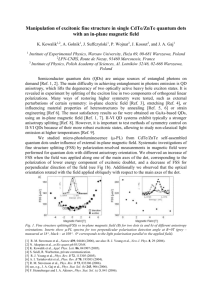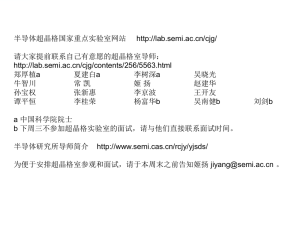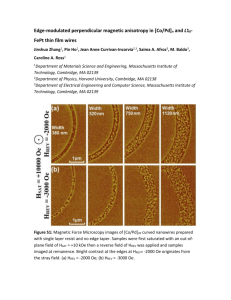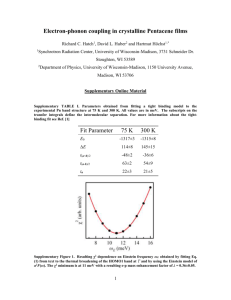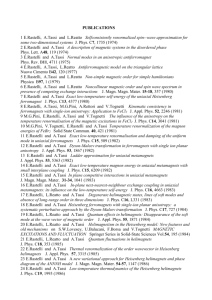Supplemental_Material
advertisement
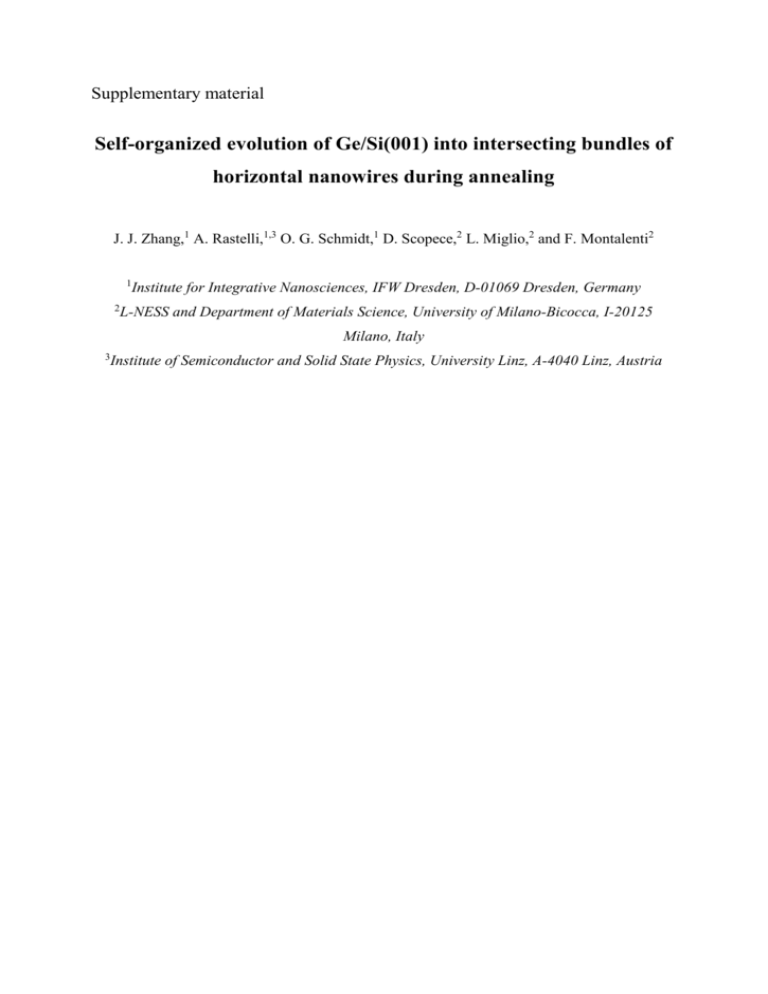
Supplementary material
Self-organized evolution of Ge/Si(001) into intersecting bundles of
horizontal nanowires during annealing
J. J. Zhang,1 A. Rastelli,1,3 O. G. Schmidt,1 D. Scopece,2 L. Miglio,2 and F. Montalenti2
1
2
Institute for Integrative Nanosciences, IFW Dresden, D-01069 Dresden, Germany
L-NESS and Department of Materials Science, University of Milano-Bicocca, I-20125
Milano, Italy
3
Institute of Semiconductor and Solid State Physics, University Linz, A-4040 Linz, Austria
Experiments:
Fig. S1. AFM images showing Ge structures obtained after 30 min. (a, c) and 12 h (b, d) annealing.
The initially deposited 4.4 ML Ge wetting layer and the subsequent in-situ annealing both are
performed at the same T of 560ºC. Ge wires and sparse plastically relaxed islands (c) are observed
after 30 min. annealing. The presence of dislocated islands with a low chemical potential causes
Ostwald ripening, which leads to the gradual disappearance of the huts and wires. After 12 h annealing,
the dislocated islands become larger after having incorporated more Ge (d). We note that we do not
see a clear denuded zone around the dislocated island as observed in Ref. [1]
Fig. S2. AFM image of the surface of a sample obtained by annealing Ge for 12 h at 540ºC and
subsequent etching for 3 minutes in NHH solution [1:1 vol. (28% NH4OH) : (31% H2O2)], which
selectively removes SiGe alloy [2]. After 3 minutes etching in NHH, we see that the wires have been
completely removed. Shallow trenches around the original wires and deep trenches up to 5Å in
between wires were observed, as indicated by dark lines in the image and by the inset, which averages
60 linescans taken perpendicular to the trenches in the area marked by a red rectangle. Such
observations show that some Si has been ejected from the substrate and implies that some Si-Ge
intermixing takes place during the wire growth process, similar to the observation of trenches around
SiGe islands [3, 4].
Theory:
Here we shall make use of the same wave-model introduced in Ref. [5], the only difference
being that (001) surface energy values (still taken from Ref. [6]) are used instead of the ones
for (1 1 10).
For sake of simplicity we model both the WL and the island to be 100% Ge, a condition not
far to be met in experiments because of the small slope of the islands [7].
As done in Ref. [5], we model the formation of satellites stemming from the excavated
material due to the prolongation of 105 facets (see Fig. 3(a) of the manuscript) and we do so
by neglecting the terminations of the wires, an assumption that allows us to have a 2D model
as in Ref. [7].
In order to assess the stability we compare the energy of the situation with symmetric
satellites (panel b) with the one with just the precursor (panel a), both laying on a N-ML-thick
WL.
The total energy of each configuration per unit length orthogonal to the page is:
E
eff
AGe Ge L105 105
L001 001 ( N ) m edge
(1)
Here Ge is the elastic energy density per unit volume of Ge present in the cell (VGe=AGe*).
It is computed with a finite element method where ab initio elastic constants are used. is the
surface energy density of 105 and the WL 001 whose total length is L.
The surface energy of the WL is a function of N and is taken from the interpolation data
reported in Ref. [6]. The effective surface energy of the {105} facet is obtained by taking into
account both the local strain and the distance of every point of the surface from the Si–Ge
interface [5, 6]. edge is the edge energy density. Exploiting previous results [5] we assign to
the top edge of each wire the value of 370 meV/A, although it was originally obtained for the
case of wires on (1 1 10) substrate. m is the number of top edges in the cell (3 in the case of
satellites, 1 in the case of the precursor cell).
The difference of total energy for various N as a function of the base of the satellites is
reported in Fig. 3(b) in the main manuscript and we refer there for its discussion.
The stability obtained in this case is very different from the one deduced in Ref. [5], in
particular here the onset of the wave is retarded in comparison to the case of (1 1 10)
substrates.
This is mostly due to the higher difference in surface energy between 1 1 10 and 105 than
between 001 and 105 [6] and just slightly due to the higher inclination of the facets (11° on
001 vs 8° on 1 1 10). This is proven by the fact that a similar stability to the 1 1 10 case is
recovered by taking the same geometry of 001 wires and using the surface energies obtained
in the case of 1 1 10 wires (not shown).
[1] M. R. Mckay, J. Shumway, and J. Drucker, J. Appl. Phys. 99, 094305 (2006).
[2] A. Rastelli, M. Stoffel, A. Malachias, T. Merdzhanova, G. Katsaros, K. Kern, T. H.
Metzger, and O. G. Schmidt, Nano Lett. 8, 1404 (2008).
[3] X. Z. Liao, J. Zou, D. J. H. Cockayne, J. Qin, Z. M. Jiang, X. Wang, and R. Leon, Phys.
Rev. B 60, 15605 (1999).
[4] S. A. Chaparro, Y. Zhang, and J. Drucker, Appl. Phys. Lett. 76, 3534 (2000).
[5] G. Chen, B. Sanduijav, D. Matei, G. Springholz, D. Scopece, M. J. Beck, F. Montalenti,
and L. Miglio, Phys. Rev. Lett. 108, 055503 (2012).
[6] D. Scopece, F. Montalenti, and M. J. Beck, Phys. Rev. B 85, 085312 (2012).
[7] J. J. Zhang, G. Katsaros, F. Montalenti, D. Scopece, R. O. Rezaev, C. Mickel, B.
Rellinghaus, L. Miglio, S. De Franceschi, A. Rastelli, and O. G. Schmidt, Phys. Rev. Lett.
109, 085502 (2012).
